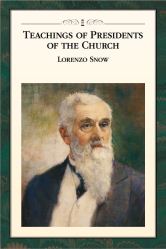Chapter 16 – That We May Become One
This chapter is a perfect example of how deep we have to go sometimes to distinguish the differences between Christianity and Mormonism. Snow is stressing the need for unity within the Saints and there should be no conflict between them. As a theme and a rule for Christian life, this is not something that Christians can disagree with at all. Matthew 18:15-20 is a clear example of how the Bible sets out clear standards for how to resolve differences between brothers and sisters in faith. This chapter does however point towards substantial differences between Mormonism and Christianity such as the non-Trinitarianism of Mormonism. This chapter also raises other issues such as division between the apostles and whether division is helpful within the church, which shall be explored in this review.
On page 196, Snow makes a very interesting statement regarding the Father and the Son. When Jesus prays for the believers in the Garden, he pleads that the believers are of ‘one’ ‘just as you are in me and I am in you’ (John 17:21). Building on that verse Snow states that:
‘There is something very important in this, and we have got to practice ourselves until we become like the Father and the Son, one in all things’.
This may not seem like a statement of great importance, but when we link the verse itself with other Mormon theology, we can see that this statement is actually very telling. The King James Version of John 17:21 does not mention the terms ‘Father’ or ‘Son’ so Snow has not built this statement on the version of the Bible that the LDS use. Instead this statement reflects the Mormon theology of the Father and the Son. When we investigate the Mormon view of Acts 7 and the stoning of Stephen, we can see that this is the primary text for the Mormon justification of Jesus being a separate god to the Father as expressed in the Pearl of Great Price – Joseph Smith, History 1:17. Bearing this in mind, it is not hard to see how this doctrine has been implanted onto this verse. The changing of terminology from ‘you’ and ‘me’ to ‘Father’ and ‘Son’ may seem innocuous but given the Mormon theology of the separate godship of the Son, it is easy to see that this change could have, and probably has, occurred due to this distinctive heterodox theology
This also leads onto another interesting issue, the lack of any mention of the Holy Spirit in this. To be clear, Mormonism does not teach that the Holy Spirit is not a distinctive ‘godly being’ such as the Father and the Son. McConkie does describe the Holy Spirit as a ‘Personage of Spirit’ who is only in one place at one time and is not manifest (D&C 130:22-23; McConkie, Mormon Doctrine, 1966, 359). This anti-trinitarianism seems to be implicit in this statement. The verse from John does not deny the trinity or make any reference to any distinctive labels of ‘Father’ or ‘Son’. The perfect unity and the perfect unity is in the Trinity, not the Mormon ‘godhead’ but the Trinity. An interesting aside to mention at this point is D&C 20:28 which states that:
Which Father, Son, and Holy Ghost are one God, infinite and eternal, without end. Amen.
The above statement does imply Trinitarian thought within some of the Mormon scriptures. This is interesting when we consider what Snow is saying. Snow is correct in saying the Father and the Son are one in all things but to not include the Spirit not only neglects the three chapters that precede John 17 and the discussion of the advocate but it also neglects the true unity and community as shown in Matthew 28. Snow’s idea of unity for the saints is fundamentally flawed because he neglects the perfect unity that is the foundation of all creation for the Mormon idea of the godhead.
The very next paragraph in page 196 identifies the next issue that we face with Snow’s understanding of unity. Snow argues that:
‘For unless the Apostles and those that believed on them were united, the world could not believe in the mission and purposes of the Saviour’.
This raises some interesting questions about how can humanity can affect the mission of the world but also whether Snow is missing out certain sections of the apostolic ministry and history. One of the key defenses of the Mormon faith is that the apostolic authority was lost after the death of the apostles. Whilst we will not be looking into this in detail, it is important to remember this when we investigate this statement. Galatians 2:12 and Acts 15:7 recounts the disagreement that was had between Paul and James about whether Gentiles and Jews could eat together and how Peter was could in the middle and was making a mess of sitting on the fence. It is fair to say that there was a fair old argument between the three and there were probably some harsh words said. Paul doesn’t really hold back in Galatians about how he felt. This is a clear scriptural sign that there was division within the apostolic community; something that Snow implies should not be the case. The statement implies that the apostolic mission cannot be done if there is division yet it cannot be denied that the work continued and was blessed. Even in the Mormon thought world, the apostolic authority hadn’t been lost yet as the apostles were not dead yet. Snow seems to have completely overlooked this and has also seemed to once again link human efforts to the work of God. The work of God does not stop because of human sin. The Old Testament is full of stories about how the work of God overcame human sinfulness, a perfect example of this is the story of Jonah. To argue that the work of God cannot be done because of human actions limits God. In effect, Snow is saying humanity has power of God, something that is frankly heretical.
Our final point of investigation may seem rather minor in the grand scheme of things, but it does reveal something of the very nature of how Mormonism views debates, argument and disunity in faith. In the section ‘Unity is essential in the Church and in our families’, Snow describes how the quorum of the Twelve is a ‘perfect union’ and the relationship between every branch of the LDS church should also be a ‘perfect union’. This is not a sentiment that I believe to be disingenuous or false on Snow’s part. The flaw with this though is what isn’t said. Snow does talk about not resting day or night until he had union with somebody but there is no description of the ‘hows’. There is always division in any human community; this is a fact of life. Snow’s earlier comments that division will cause us not to be the people of God does overlook, as we discussed earlier, how God sometimes uses our division to bring forth His truth. These sentiments are also unhelpful in dealing with conflict as there are no helpful tools to deal with it. Matthew 18 provides helpful tools to resolve conflict. Unity here is the expected behaviour and if you do not conform for what ever, sometimes justified, reasons then you are not living to the standards that are expected. It would be unhelpful to link this teaching to some of the stories of ‘authoratative’ LDS leadership strategies (e.g. The September Six), but it does suggest that the Mormonism doesn’t allow for some debate and dissention which is unbiblical as the Bible does show us that the Word of God often is clearest at times of dissention.
In conclusion, we can see that our familiar pattern in terms of Mormon thought buried deep with Christian sounding ideas returning in this chapter. Unity within the church is a very Biblical idea and not something that should be mocked or undermined. Snow however does seem to ignore the most perfect unity of the Trinity as well as miss the examples of how God works through division in the Bible which is unfortunate and shows the clear differences between Mormonism and Christianity.










Leave a Reply